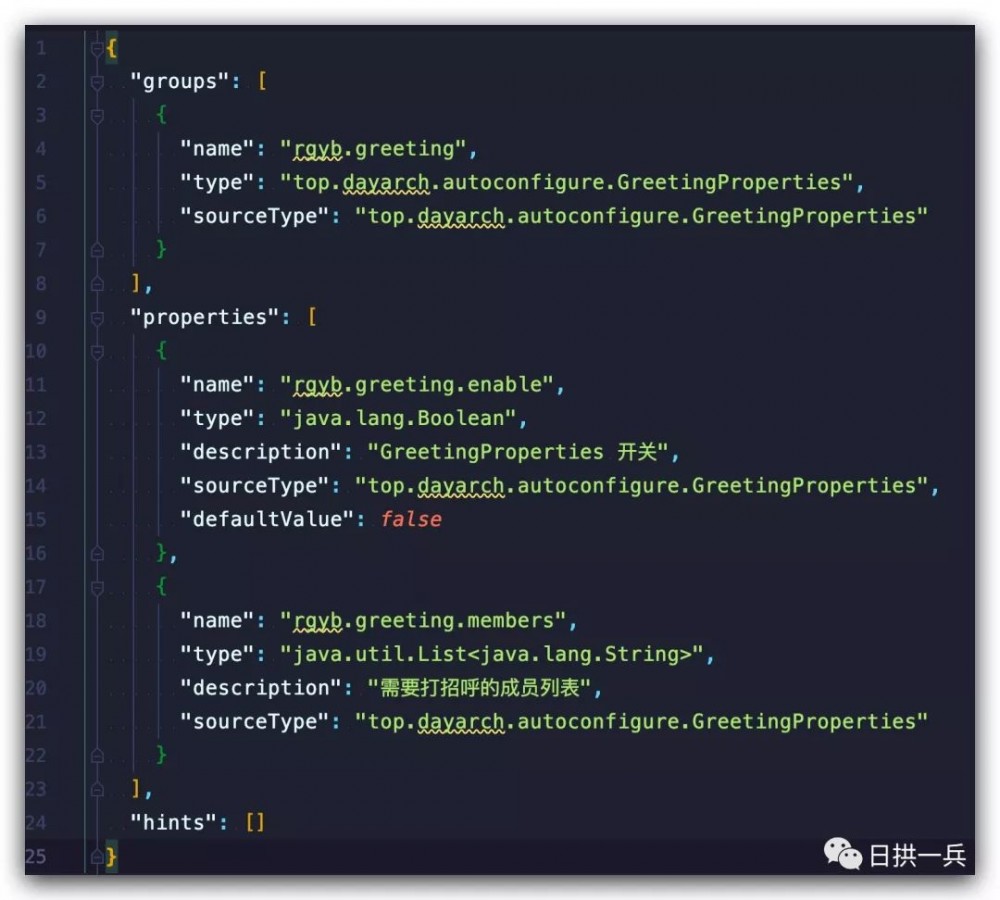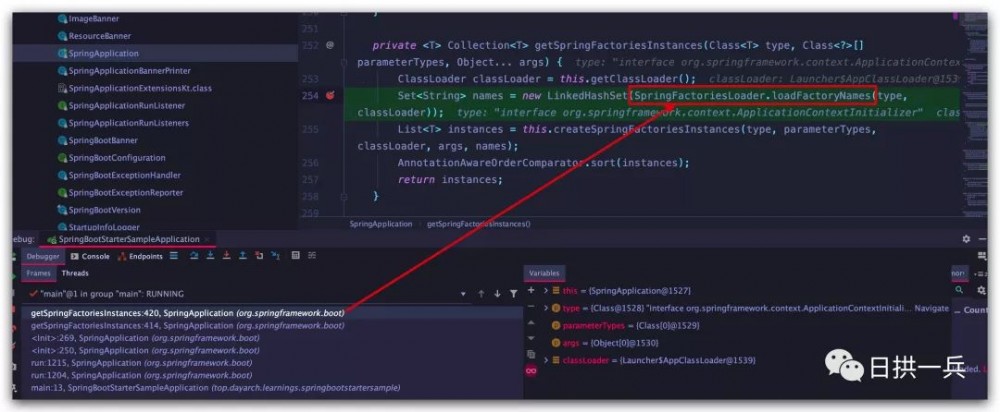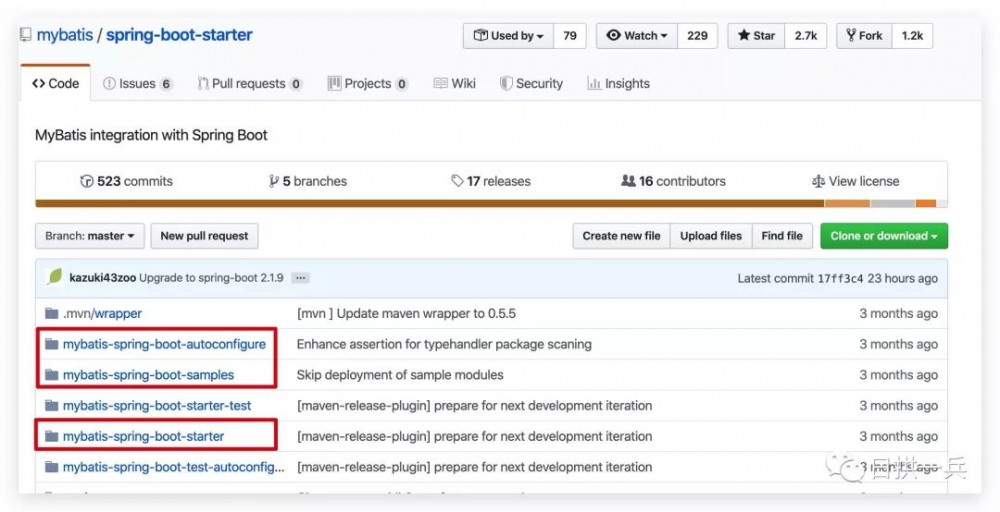手把手教你定制标准 Spring Boot starter
点击上方蓝色“ 程序猿DD ”,选择“设为星标”
回复“ 资源 ”获取独家整理的学习资料!

写在前面
我们每次构建一个 Spring 应用程序时,我们都不希望从头开始实现具有「横切关注点」的内容;相反,我们希望一次性实现这些功能,并根据需要将它们包含到任何我们要构建的应用程序中
横切关注点: 指的是一些具有横越多个模块的行为 (来自维基百科的介绍) 说白了就是多个项目或模块都可以用到的内容,比如一个 SDK
在Spring Boot中,用于表示提供这种横切关注点的模块的术语是 starter ,通过依赖 starter 可以轻松使用其包含的一些功能特性, 无论你的工作中是否会构建自己的 starter,你都要具有构建 「starter」的思想 ,本文将结合 Spring Boot 官方标准构建一个简单的 starter
自定义 starter
在我们深入了解如何自定义 starter 之前,为了更好的理解我们每一步在干什么,以及 starter 是如何起作用的,我们先从宏观角度来看 starter 的结构组成到底是什么样的
通常一个完整的 starter 需要包含下面两个组件:
-
Auto-Configure Module
-
Starter Module
如果你看下面这两个组件的解释有些抽象,大概了解一下,阅读完该文章回看这里就会豁然开朗了
Auto-Configure Module
Auto-Configure Module (自动配置模块) 是包含自动配置类的 Maven 或 Gradle 模块。通过这种方式, 我们可以构建可以自动贡献于应用程序上下文的模块,以及添加某个特性或提供对某个外部库的访问
Starter Module
Spring Boot Starter 是一个 Maven 或 Gradle 模块,其唯一目的是提供 "启动" 某个特性所需的所有依赖项。可以包含一个或多个 Auto-Configure Module (自动配置模块)的依赖项,以及可能需要的任何其他依赖项。这样,在Spring 启动应用程序中,我们只需要添加这个 starter 依赖就可以使用其特性
:warning:: Spring 官方参考手册建议将自动配置分离,并将每个自动配置启动到一个独立的 Maven 或 Gradle 模块中,从而将自动配置和依赖项管理分离开来。如果你没有建立一个供成千上万用户使用的开源库,也可以将二者合并到一个 module 中 You may combine the auto-configuration code and the dependency management in a single module if you do not need to separate those two concerns
命名
来自 Spring 官方的 starter 都是 以 spring-boot-starter 开头,比如:
-
spring-boot-starter-web
-
spring-boot-starter-aop
如果我们自定义 starter 功能名称叫 acme ,那么我们的命名是这样的:
-
acme-spring-boot-starter
-
acme-spring-boot-autoconfigure
如果 starter 中用到了配置 keys,也要注意不要使用 Spring Boot 使用的命名空间,比如(server,management,spring)
Parent Module 创建
先来全局看一下项目结构: 一级目录结构:
. ├── pom.xml ├── rgyb-spring-boot-autoconfigure ├── rgyb-spring-boot-sample └── rgyb-spring-boot-starter
二级目录结构:
.
├── pom.xml
├── rgyb-spring-boot-autoconfigure
│ ├── pom.xml
│ └── src
├── rgyb-spring-boot-sample
│ ├── pom.xml
│ └── src
└── rgyb-spring-boot-starter
├── pom.xml
└── src
创建一个空的父亲 Maven Module,主要提供依赖管理,这样 SubModule 不用单独维护依赖版本号,来看 pom.xml 内容:
<dependencyManagement>
<dependencies>
<dependency>
<groupId>org.springframework.boot</groupId>
<artifactId>spring-boot-dependencies</artifactId>
<version>${spring-boot.version}</version>
<type>pom</type>
<scope>import</scope>
</dependency>
</dependencies>
<!-- 添加其他全局依赖管理到这里,submodule默认不引入这些依赖,需要显式的指定 -->
</dependencyManagement>
Auto-Configure Module 构建
新建类 GreetingAutoConfiguration
@Configuration
public class GreetingAutoConfiguration {
@Bean
public GreetingService greetingService(GreetingProperties greetingProperties){
return new GreetingService(greetingProperties.getMembers());
}
}
我们用 @Configuration 注解标记类 GreetingAutoConfiguration,作为 starter 的入口点。这个配置包含了我们需要提供starter特性的所有 @Bean 定义,在本例中,为了简单阐述问题,我们只将 GreetingService Bean 添加到应用程序上下文
GreetingService 内容如下:
@AllArgsConstructor
public class GreetingService {
private List<String> members = new ArrayList<>();
public void sayHello(){
members.forEach(s -> System.out.println("hello " + s));
}
}
在 resources 目录下新建文件 META-INF/spring.factories (如果目录 META-INF 不存在需要手工创建),向文件写入内容:
org.springframework.boot.autoconfigure.EnableAutoConfiguration=/ top.dayarch.autoconfigure.GreetingAutoConfiguration
Spring 启动时会在其 classpath 中所有的 spring.factoreis 文件,并加载里面的声明配置,GreetingAutoConfiguration 类就绪后,我们的 Spring Boot Starter 就有了一个自动激活的入口点
到这里这个 "不完全的 starter" 已经可以使用了。但因为它是自动激活的,为了个让其灵活可用,我们需要让其按照我们的意愿来激活使用,所以我们需要条件注解来帮忙
条件配置
为类添加两个条件注解:
@Configuration
@ConditionalOnProperty(value = "rgyb.greeting.enable", havingValue = "true")
@ConditionalOnClass(DummyEmail.class)
public class GreetingAutoConfiguration {
...
}
-
通过使用
@ConditionalOnProperty注解,我们告诉 Spring,只有属性rgyb.greeting.enable值被设置为 true 时,才将 GreetingAutoConfiguration (以及它声明的所有 bean ) 包含到应用程序上下文中 -
通过使用
@ConditionalOnClass注解,我们告诉Spring 只有类 DummyEmail.class 存在于 classpath 时,才将 GreetingAutoConfiguration (以及它声明的所有 bean ) 包含到应用程序上下文中
多个条件是 and/与 的关系,既只有满足全部条件时,才会加载 GreetingAutoConfiguration
如果你对条件注解的使用还不是很明确,可以查看我之前的文章: @Conditional注解,灵活配置 Spring Boot
配置属性管理
上面使用了 @ConditionalOnProperty 注解,实际 starter 中可能有非常多的属性,所以我们需要将这些属性集中管理:
@Data
@ConfigurationProperties(prefix = "rgyb.greeting")
public class GreetingProperties {
/**
* GreetingProperties 开关
*/
boolean enable = false;
/**
* 需要打招呼的成员列表
*/
List<String> members = new ArrayList<>();
}
我们知道这些属性是要在 application.yml 中使用的,当我们需要使用这些属性时,为了让 IDE 给出更友好的提示,我们需要在 pom.xml 中添加依赖:
<dependency>
<groupId>org.springframework.boot</groupId>
<artifactId>spring-boot-configuration-processor</artifactId>
<optional>true</optional>
</dependency>
这样当我们 mvn compile 时,会在生成一个名为 spring-configuration-metadata.json JSON 文件,文件内容如下:

生成的内容在接下来的内容中用到,且看
提升启动时间
对于类路径上的每个自动配置类,Spring Boot 必须计算 @Conditional… 条件值,用于决定是否加载自动配置及其所需的所有类,根据 Spring 启动应用程序中 starter 的大小和数量,这可能是一个非常昂贵的操作,并且会影响启动时间,为了提升启动时间,我们需要在 pom.xml 中添加另外一个依赖:
<dependency>
<groupId>org.springframework.boot</groupId>
<artifactId>spring-boot-autoconfigure-processor</artifactId>
<optional>true</optional>
</dependency>
这个注解会生成一个名为 spring-autoconfigure-metadata.properties Property 文件,其内容如下:

这样,Spring Boot 在启动期间读取这些元数据,可以过滤出不满足条件的配置,而不必实际检查这些类,提升启动速度
到这里关于 Auto-Configure Module 就构建完了,我们需要继续完成 Starter Module 的构建
Starter Module 构建
Starter Module 的构建很简单了,你可以认为它就是一个空 module,除了依赖 Auto-Configure Module,其唯一作用就是为了使用 starter 功能特性提供所有必须依赖,所以我们为 starter module 的 pom.xml 文件添加如下内容:
<dependencies>
<dependency>
<groupId>top.dayarch.learnings</groupId>
<artifactId>rgyb-spring-boot-autoconfigure</artifactId>
<version>1.0.0.RELEASE</version>
</dependency>
<!-- 在此处添加其他必要依赖,保证starter可用 -->
</dependencies>
同样在 resources 目录下新建文件 META-INF/spring.providers , 其内容如下:
providers: rgyb-spring-boot-autoconfigure
该文件主要作用是说明 starter module 的依赖信息,多个依赖以逗号分隔就好,该文件不会影响 starter 的使用,可有可无
Starter Module 就可以这么简单,将两个 module 分别 mvn install 到本地 Maven Repository,接下来我们创建 sample module 引入这个 starter 依赖时就会从本地 Maven Repository 中拉取
创建 Sample Module
我们可以通过 Spring Initializr 正常初始化一个 Spring Boot 项目 (rgyb-spring-boot-sample),引入我们刚刚创建的 starter 依赖,在 sample pom.xml 中添加依赖:
<dependency>
<groupId>top.dayarch.learnings</groupId>
<artifactId>rgyb-spring-boot-starter</artifactId>
<version>1.0.0.RELEASE</version>
</dependency>
接下来配置 application.yml 属性
rgyb:
greeting:
enable: true
members:
- 李雷
- 韩梅梅
在我们配置 YAML 的时候,会出现下图的提示,这样会更友好,当然为了规范,属性描述最好也用英文描述,这里为了说明问题用了中文描述:

编写测试类
我们编写测试用例:
@Autowired(required = false)
private GreetingService greetingService;
@Test
public void testGreeting() {
greetingService.sayHello();
}
测试结果如下:
hello 李雷 hello 韩梅梅
总结
到这里完整的 starter 开发就结束了,希望大家了解其构建过程,目录结构及命名等标准,这样有相应的业务需求时都可以开发自己的 starter 被其他人应用起来
starter 开发好了,别人可以手动添加依赖引入 starter 的相关功能,那我们如何像 Spring Initializr 一样,通过下来菜单选择我们的 starter 呢,这样直接初始化好整个项目,接下来的文章我们会模仿 Spring Initializr 自定义我们自的 Initializr
知识点说明
Dependency optinal
为什么 Auto-Configure Module 的 dependency 都是 optional = true 呢?
这涉及到 Maven 传递性依赖的问题,详情请看 Maven 依赖传递性透彻理解
spring.factories
Spring Boot 是如何加载这个文件并找到我们的配置类的
下图是 Spring Boot 应用程序启动的调用栈的一部分,我添加了断点:

打开 SpringFactoriesLoader 类,映入眼帘的就是这个内容:

这两张图应该足够说明问题了,是 SPI 的一种加载方式,更细节的内容请大家自己去发现吧
实际案例
这里推荐查看 mybatis-spring-boot-starter 这个非 Spring 官方的案例,从中我们:
-
模仿其目录结构
-
模仿其设计理念
-
模仿其编码规范

另外,本文的案例我已上传,公众号回复「demo」,打开链接,查看 customstarter 目录下内容即可
灵魂追问
-
在生成 spring-autoconfigure-metadata.properties 文件时,为什么 @ConditionalOnProperty 的内容没有被写进去
-
如果我们要将依赖上传至 remote central repository,你知道怎样搭建自己的 maven repository 吗?
-
你的灯还亮着吗?
本文通过OpenWrite的免费Markdown转换工具发布
留言交流不过瘾
关注我,回复“ 加群 ” 加入各种主题讨论群

-
经典面试题:Redis 内存满了怎么办?
-
一个不错的权限管理模块设计案例
-
怎么向女朋友解释什么叫区块链?
-
7 个显著提升编码效率的IntelliJ IDEA必备插件
-
“12306”的架构到底有多牛逼?
朕已阅
- 本文标签: remote 开发 cat Service 灵魂 Markdown spring 插件 src redis 希望 json classpath dependencies tar Property 时间 ArrayList 目录 list mail provider 数据 AOP App 测试 mybatis js 免费 需求 EnableAutoConfiguration value pom 开源 UI IO CTO 定制 程序猿 https 文章 管理 Spring Boot key maven 总结 配置 bean 空间 web 12306 struct http IDE id XML
- 版权声明: 本文为互联网转载文章,出处已在文章中说明(部分除外)。如果侵权,请联系本站长删除,谢谢。
- 本文海报: 生成海报一 生成海报二










![[HBLOG]公众号](https://www.liuhaihua.cn/img/qrcode_gzh.jpg)

